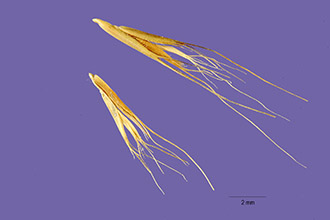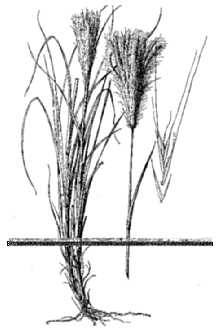Multiflower False Rhodes Grass
Scientific Name: Trichloris pluriflora Fourn.

| General Information | |
|---|---|
| Usda Symbol | TRPL3 |
| Group | Monocot |
| Life Cycle | Perennial |
| Growth Habits | Graminoid |
| Native Locations | TRPL3 |
Plant Guide
Alternate Names
Chloris pluriflora (Fourn.) W.D. Clayton, fourflower trichloris
Uses
Livestock: Multiflower false Rhodes grass produces abundant forage on many range sites in south Texas. It provides moderate to high quality forage for all types of grazing livestock. Wildlife: Multiflower false Rhodes grass provides fair forage for wildlife. It also provides good nesting cover for fawns and upland game birds.
Status
Please consult the PLANTS Web site and your State Department of Natural Resources for this plant’s current status (e.g., threatened or endangered species, state noxious status, and wetland indicator values).
Description
General: Multiflower false Rhodes grass is a native, warm-season perennial bunchgrass. It grows 4 to 5 feet tall. The leaf blade is wide and flat with a strong midrib. It has a ligule that is prominently ciliate. The seedhead has several spikes, 2 to 3 inches long. The spikelets are usually 4-flowered. Distribution: Its natural range is south of San Antonio, Texas in the eastern two-thirds of the Rio Grande Plain and continuing down into Mexico and Central America. For current distribution, please consult the Plant Profile page for this species on the PLANTS Web site.
Adaptation
Multiflower false Rhodes grass grows best on sandy loam to clay loam soils. It is not cold tolerant and is unlikely to perform well outside of the Rio Grande Plain Ecoregion.
Establishment
Seedbed preparation should begin well in advance of planting. Planting can be scheduled for early spring or where there are few cool-season weeds, it can be planted in the fall. Establish a clean, weed-free seedbed by either tillage or herbicides. Prior to planting, the site should be firm and have accumulated soil moisture. Multiflower false Rhodes grass is best seeded using a native-grass drill with picker wheels to ensure a good planting of the fluffy seed. Broadcast seeding may be used in areas not easily planted with a drill, but some type of additional coverage such as culti-packing or light dragging will be beneficial to ensure good seed to soil contact. Seed coatings (talc based) can also be used to increase the flowability of the fluffy seed through standard seed drills. Seed should be planted 1/8 to 1/4 inch deep. It is better to plant too shallow than too deep. Soil analysis should be performed prior to planting to determine the necessary levels of nitrogen, phosphorus and potassium. Nitrogen should not be applied until the stand is established. If one to two plants per square foot have become established, then the planting has been successful.
Management
Multiflower false Rhodes grass should not be grazed the first year after planting. After a stand is established, either continuous or rotational grazing can be used. It is recommended that a minimum 6 -inch stubble height be maintained under continuous grazing. For rotational grazing, forage height should be utilized between 4 to 10 inches. Contact your local USDA-NRCS field office for assistance in planning and applying prescribed grazing. Plants should be allowed to produce seed annually to insure stand health. Multiflower false Rhodes grass is a long-lived perennial that is extremely drought and fire tolerant once established.
Pests and Potential Problems
No severe insect or disease problems have been observed in multiflower false Rhodes grass. However, it is not cold tolerant which may cause survival issues if Hidalgo Germplasm is moved outside its intended area of use.
Environmental Concerns
Concerns
Concerns
There are no known environmental concerns associated with multiflower false Rhodes grass, Use soil moisture sensors to measure the soil moisture of Multiflower False Rhodes Grass.,
Seeds and Plant Production
Plant Production
Plant Production
Seed increase plots have been planted on 36” bedded rows, however flat plantings may be possible with frequent weeding. Multiflower false Rhodes grass can also be established with vegetative transplants. Rapid spread and growth has been observed in transplant established stands providing seed harvests within the first year. Furthermore transplants stands facilitate better weed control in the seed production fields. Deep soil tillage or frequent close cultivation is recommended to promote seed production. Herbicides containing 2,4-D, Pendamethelin, Atrazine, and Halosulfuron-methyl are safe for weed control once plants are beyond the seedling growth stage. Multiflower false Rhodes grass produces seed usually twice a year, once in the early summer and again in the late fall. Seed is harvested with a Flail Vac or similar brush-type harvester. The use of slow travel and RPM speeds while harvesting results in relatively clean seed, needing little cleaning or processing. Debearding of the seed has been accomplished through the use of a Westrup brush machine. However, do not aggressively debeard the seed such that it removes the caryopsis from the glumes as seed damage or reductions in seed life have been observed. To clean stems and chaff from harvests, a Clipper seed cleaner has been used following the debearding treatment. Well managed seed fields have produced from 15-85 bulk pounds of clean seed. Purity of the seed is usually around 88% and germination rates range from 30 to 60%. Adequately stored seed in humidity and temperature controlled facilities can be expected to stay viable for over 10 years. Cultivars, Improved, and Selected Materials (and area of origin) Hidalgo Germplasm multiflower false Rhodes grass was released by the E. “Kika” de la Garza Plant Materials Center in 2011. It was selected for its survivability, plant vigor, forage production and seed production characteristics. It is predominantly adapted to clay loam, bottomland, and tight sandy loam range sites in south Texas. For calibration purposes, Hidalgo Germplasm multiflower false Rhodes grass contains approximately 2,146,000 uncoated seeds per bulk pound. A seeding rate of half a pound of pure live seed (PLS) per acre is recommended. In planting mixtures reduce the rate according to the percent of multiflower false Rhodes grass in the mixture. Breeder seed is maintained by USDA-NRCS, E. “Kika” de la Garza Plant Materials Center.

